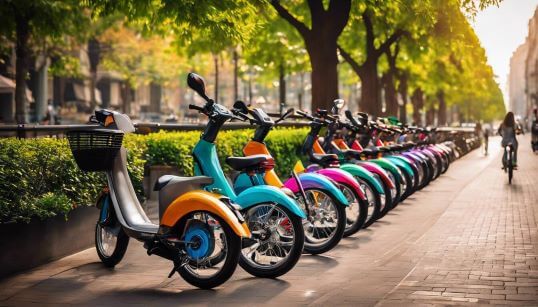With rising fuel prices, the carbon footprint of travel, and the constant buzz of traffic, Britons are readjusting their ride. Enter the era of electric bikes – swift, sustainable, and sensational! It’s 2023, and one in seven bikes darting through UK back lanes to bustling cityscapes is electric. This blog post delves into why this shift has occurred and expounds on the benefits of tempting UK denizens to turn the key and go e-bike. Strap up because we’re about to traverse the reasons behind the skyrocketing popularity of electric bikes in the UK.
Electric bikes, or e-bikes, have become increasingly popular in the UK due to their ability to cut commute time and avoid congestion, reduce carbon footprint, save money on running costs and road tax, improve health and lifestyle, and enable a wider range of people to cycle. Additionally, research by Mintel shows that around 2.78 million people in the UK are likely to buy an e-bike in the next 12 months, indicating continued growth in e-bike purchases. Despite their higher upfront cost compared to regular bicycles and battery limitations, e-bikes continue to gain traction as a sustainable and practical transportation option.

UK’s Rising Trend: Electric Bikes
In recent years, the United Kingdom has witnessed a remarkable surge in the popularity of electric bikes. The sheer number of people opting for these eco-friendly alternatives to traditional bicycles and motorbikes is a testament to their numerous advantages. Just take a stroll through the bustling streets of London or any major UK city, and it won’t be long before you spot someone effortlessly gliding through traffic on an electric bike.
So, what factors have contributed to the rising trend of electric bikes in the UK?
- Public Transport problems – A lot of people rely on public transport to get to work or indeed get around, but public transport is now very expensive, getting a bus journey can cost you £5 and a train journey can cost you a fortune, people are looking for ways to remove this cost from their bills e0bikes are a great way, if you can save £30 a month on public transport do you think it’s worth it?
- Traffic When Commuting – Not only do you have to pay to commute if you work in a busy city, then likely you are to have to sit in traffic for a large amount of time, it used to take me an hour to get home in my car from the town centre I can do it quicker than that on my electric bike, I think generally it is slowly to cycle but not by much.
- Eco-Friendly – Owning and riding an e-bike does not cost a lot, as the battery packs are rechargeable, it does not cost a lot to charge from empty to full maybe 20p, this is obviously greener than getting on a bus or train as there are zero emissions from an ebike, people are more conscious of this now. It is a very easy way for someone to reduce their carbon footprint.
- Health Benefits – Boost Your Fitness with an E-bike! While it’s true that traditional cycling can ramp up your fitness levels, don’t underestimate the power of an e-bike. These pedal-assist marvels kick in when you do, blending your effort with a touch of electric magic. Perfect for tackling the UK’s notorious hills, they turn a daunting ride into a manageable journey. Say goodbye to arriving at work drenched in sweat and needing a shower; with an e-bike, you get the exercise benefits without the unwanted workout aftermath. Embrace a healthier, more enjoyable cycling experience – e-bike style!
- Commuting time is saved – If you can combine getting fitter with going to work then it’s a quick win for most people, you do not need to go to the gym cycling is your workout, and this wasted time in your day travelling is turned into a workout.
- Speed and Range– You can go faster than you would be able to on a normal pedal cycle, now its not like a motorbike, you still have to pedal to make the motor turn on, but most bikes will have a good range and be able to keep you going faster generally than traffic does in peak hours.
- Adaptability – You can get small bikes, and folding ebikes you can take in your office at work, and some lightweight ebikes, different sizes and different styles, sizes, there is an electric bike for everyone, and you can use them to deliver food, and get your shopping go to the pub, the possibilities are endless.

The downside is the initial cost of owning an ebike you can find out why here, one obvious downside is the weather!
Benefits of E-Bikes for UK Commuters
Electric bikes offer an array of advantages specifically tailored to meet the needs of UK commuters. These benefits have played a significant role in the increasing adoption of electric bikes as a preferred mode of transportation.
- Electric bikes have become increasingly popular among UK commuters due to the numerous advantages they offer, which are tailored to meet their needs.
Combatting Congestion and Cutting Commute Time
One of the key factors contributing to the popularity of electric bikes (e-bikes) in England is their ability to combat congestion and significantly cut commute time. With urban areas constantly struggling with traffic jams and overcrowded public transport, e-bikes offer a convenient alternative mode of transportation that can bypass these issues. Unlike traditional bicycles, e-bikes are equipped with an electric motor that provides assistance when pedalling, allowing riders to effortlessly navigate through congested roads.
Consider this scenario: Jane lives in a bustling city with heavy traffic. Every day, she used to spend hours commuting to work in her car, frustrated by the never-ending sea of brake lights. However, after switching to an e-bike, Jane found herself effortlessly weaving through traffic, avoiding gridlock and arriving at her destination faster than before. The ability of e-bikes to bypass traffic congestion is not only a practical solution for individuals like Jane but also has broader implications for reducing overall traffic congestion in cities.
Aside from combatting congestion, e-bikes also possess numerous benefits when it comes to cutting commute time.
E-bikes allow riders to travel at higher speeds compared to traditional bicycles while requiring less physical exertion. This makes them an ideal choice for individuals who have longer commutes or those who prefer arriving at their destination without breaking a sweat. The electric assist feature enables riders to reach higher speeds with ease, making uphill climbs or long distances more manageable and efficient.
For example, John used to rely on a regular bike for his 10-mile daily commute. While he enjoyed the exercise aspect of cycling, he often arrived at work exhausted and had limited energy for his day ahead. Switching to an e-bike allowed him to maintain a comfortable pace while covering the same distance. He arrived at work feeling refreshed and ready to take on the day, all while saving valuable time.
Now that we have explored how e-bikes combat congestion and cut commute time, let’s delve into another key factor: encouraging healthier lifestyles.

Encouraging Healthier Lifestyles
In an era when health and fitness are prioritised, electric bikes offer a way to encourage healthier lifestyles. Many people view cycling as an enjoyable form of exercise, but some may be deterred by the physical demands or long distances. E-bikes bridge this gap by providing assistance when needed, making cycling accessible to a wider range of individuals.
Sarah was someone who hadn’t ridden a bicycle in years due to various health concerns. However, after trying out an e-bike, she discovered that the electric assist allowed her to gradually reintegrate cycling into her life. She could control the level of assistance provided, gradually increasing her fitness levels while enjoying the fresh air and feeling energised by the outdoor activity. The convenience and comfort of e-bikes motivated Sarah to adopt a more active and healthier lifestyle.
Alongside promoting physical fitness, e-bikes have additional benefits for overall well-being.
Regular physical activity has been linked to improved mental health and stress reduction. By incorporating e-bike rides into their daily routine, individuals can experience the benefits of exercise while also enjoying the freedom and relaxation that come with cycling. It offers a way for people to unwind from the pressures of work or daily life, allowing them to clear their minds and improve their mental well-being.
Take Mark as an example. He has a demanding job that leaves him feeling stressed and drained at the end of each day. To combat this, he decided to incorporate evening e-bike rides into his routine. Those moments spent gliding through peaceful trails or picturesque urban streets allowed him to disconnect from work-related worries, focus on the present, and find a sense of tranquillity.
Eco-friendly Transportation
One of the key factors driving the popularity of electric bikes in England is their contribution to eco-friendly transportation. Amid concerns about climate change and air pollution, more people are seeking sustainable alternatives to traditional modes of transportation. Electric bikes offer a greener option by reducing carbon emissions and dependence on fossil fuels. They run on rechargeable batteries that power an electric motor, providing assistance to riders as they pedal. Unlike conventional motorcycles or cars, e-bikes produce zero emissions while being ridden, making them an environmentally responsible choice for daily commuting.
Imagine a bustling city like London, where thousands of commuters use various means of transport each day, contributing to traffic congestion and air pollution. Now picture someone riding an electric bike through that urban landscape. The e-bike silently zooms past gridlocked vehicles, emitting no fumes or noise pollutants. In this scenario, not only does the rider experience a pleasant and efficient commute, but they also play their part in reducing carbon footprint and improving air quality for everyone.
In addition to their environmental benefits, electric bikes also have the potential to revolutionise last-mile transportation. Many people rely on public transportation or cars for short-distance travel within cities or towns. However, e-bikes provide a convenient alternative that can help alleviate congestion and reduce reliance on crowded buses or trains. With dedicated cycling lanes becoming increasingly common in urban areas, e-bikes offer a fast and flexible way to navigate through traffic efficiently.
By choosing electric bikes as their preferred mode of transportation, individuals can actively contribute towards creating a more sustainable future for themselves and their communities.
While the rise in popularity of electric bikes is evident, it’s important to acknowledge the barriers that still exist when it comes to its widespread adoption in the UK.
You can find my top 10 benefits of bikes here.
- According to a report by Mintel, around 2.78 million people in the UK are projected to buy an e-bike in the next 12 months.
- Last year alone, about 70,000 e-bikes were sold in the United Kingdom.
- Over the past two decades, e-bikes have seen significant growth in Europe which directly influenced their popularity in the UK. The evidence of this is that 36 million e-bikes are manufactured every year in China mostly for European consumers including UK citizens.
We have more detailed information on battery technology here.
Motor Power and Speed Limits
The motor power output and speed limits for electric bikes vary depending on their classification. As previously mentioned, EAPCs have a maximum motor power output of 250 watts. This specific power limit ensures that these bikes remain in the category of pedal-assisted bicycles, providing riders with additional support when pedalling uphill or accelerating from a standstill.
The maximum assisted speed for EAPCs is 15.5mph before relying on additional pedal power. This speed restriction contributes to maintaining the distinction between electric bikes and other higher-powered vehicles like motorcycles or mopeds. By limiting the assisted speed, EAPCs prioritise safety and ensure that riders can enjoy the benefits of electric assistance while still engaging in physical exercise.
Let’s say you’re commuting to work on a daily basis, and your electric bike is an EAPC. You can comfortably cruise at speeds up to 15.5mph without breaking any regulations, all while receiving that extra boost from the electric motor when needed. This allows you to arrive at your destination efficiently and with reduced effort compared to a conventional bicycle.
On the other hand, electric mopeds have a higher top speed allowance of 28mph. While this increased speed might be appealing to some riders seeking faster transportation options, it also requires appropriate licencing and training due to safety considerations associated with maintaining control at higher speeds.
Now that we’ve explored the legal framework and motor power/speed limits for electric bikes in the UK let’s dive into another important aspect – licencing and possible insurance obligations.
E-Bike Technology Trends in the UK
As electric bikes continue to gain popularity in the UK, manufacturers are constantly pushing the boundaries of innovation to meet consumer demands. Here are some notable technology trends currently making waves:
Picture this: You’re riding an electric bike with a TFT display mounted on the handlebars, providing you with real-time information about your speed, distance travelled, battery life, and even navigation instructions. This sort of advanced display technology is becoming increasingly common among e-bikes.
One key trend is the integration of smart features into electric bikes. Many models now come equipped with Bluetooth connectivity, allowing riders to connect to their smartphones and access various functions through dedicated apps. From tracking fitness data to adjusting pedal assistance levels and even receiving notifications, these smart features enhance the overall riding experience and provide riders with greater convenience and control.
Another notable development is the emergence of more sophisticated battery technology. Lithium-ion batteries are now widely used as they offer higher energy density, longer life cycles, and faster charging times compared to traditional lead-acid batteries. These advancements have significantly increased the range and performance of electric bikes, allowing riders to travel longer distances confidently.
Moreover, e-bikes are witnessing improvements in motor technology. Brushless motors are becoming increasingly popular due to their efficiency and quieter operation. These motors also offer multiple levels of assistance that riders can adjust according to their preference or terrain conditions, further enhancing the versatility and usability of electric bikes.
With all these exciting technological advancements in the electric bike industry, there is a wide array of models and variations available to cater to different preferences and needs. Let’s explore the variations in electric bike models in the UK.
Innovations in Battery Life and Speed
Battery life and speed are two key aspects that significantly impact the riding experience on electric bikes. Over the years, advancements in technology have resulted in remarkable improvements to both of these areas.
One of the major innovations in electric bike batteries is the development of lithium-ion batteries. These batteries offer higher energy density, making them more efficient and capable of storing more power for longer rides. Moreover, they have a longer lifespan compared to older battery technologies, reducing the need for frequent replacements.
In addition to improved battery longevity, e-bikes have also seen significant progress in terms of speed. Modern electric bikes can reach speeds of up to 28 miles per hour (45 kilometres per hour), providing commuters with a quicker alternative to traditional bicycles. The ability to maintain higher speeds effortlessly allows riders to cover longer distances and reduce commuting times.
For commuters who desire an extended range without compromising on speed or performance, some e-bike models come equipped with dual batteries. This innovative approach effectively doubles the capacity of the battery system, enabling riders to travel even greater distances before needing a recharge.
Furthermore, rapid advancements in motor technology have led to more efficient and powerful electric motors that deliver enhanced acceleration and assistance while riding uphill or facing headwinds. These motors seamlessly integrate with human pedalling efforts, creating a smooth and natural feeling of support.
As battery life continues to improve, along with increased speed capabilities, it is no wonder that electric bikes have become such a popular choice among riders in the UK. This combination of extended range and enhanced speed provides a compelling argument for choosing an electric bike as a preferred mode of transportation.
Please check out the electric bikes we have in stock if you are interested, we do have the Engwe bike currently available for order.
What demographic groups are most likely to use electric bicycles in the UK?
The demographic groups most likely to use electric bikes in the UK are commuters, older adults, and eco-conscious individuals. Commuters benefit from the convenience and cost savings of electric bikes, while older adults find them helpful for maintaining mobility and staying active. Additionally, eco-conscious individuals appreciate the environmental benefits of electric bikes, as they produce zero emissions and reduce reliance on fossil fuels. According to a study by the European Cyclists’ Federation, around 44% of electric bike owners in the UK are aged 45 or above, highlighting its popularity among older adults.
What factors have contributed to the rise in popularity of e bikes in the UK specifically?
There are several key factors that have contributed to the rise in popularity of electric bikes in the UK. Firstly, the increasing concern for the environment and the desire to reduce carbon emissions has led many people to choose electric bikes as a more sustainable mode of transportation. Additionally, the improved technology and design of electric bikes have made them more efficient and reliable. The government has also played a significant role in promoting electric bikes through incentives and subsidies. According to statistics from the Bicycle Association, sales of electric bikes in the UK have doubled in the past three years, indicating a growing demand and popularity.
I'm the passionate mind behind this online web shop. As an avid cyclist, I have a particular fondness for electric bikes and scooters, believing they offer a unique sense of freedom and joy. Not only do I enjoy riding them, but I also take pride in reviewing and sharing my insights about these fantastic machines. Additionally, as someone who suffers from dry eyes, I'm committed to stocking products that genuinely enhance and improve people's lives. Dive into my shop, and you'll find a curated selection of e-bikes, scooters, and other life-enhancing products that I stand by.






